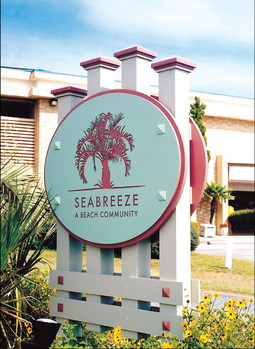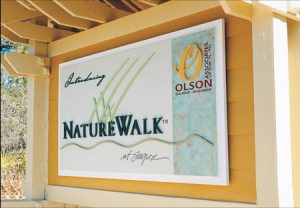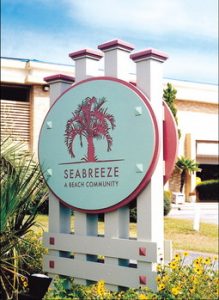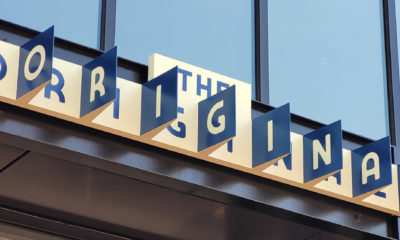Dimensional Signs
Under the Boardwalk
Boardwalk Signs’ Joe Paffoon took a fruitful chance on a second career.
Published
17 years agoon

For five years, Joe Paffoon operated a successful Atlanta-based, commercial-flooring business. His subsequent move south to the greater Panama City, FL, area didn’t mean slowing down to play shuffleboard. He opened a woodworking shop, but, when many of his customers began requesting signage, he adroitly adapted his business.
As his shop’s business and facilities grew, so did his equipment and repertoire. The real-estate market and weather events have forced Florida’s business climate into fluctuation, but the Paffoons have persevered and successfully grown their business. Now, their venture into a novel market may unearth a future niche.
“You make signs?”
In January 1997, Joe closed Board Walk Wood Shop’s Atlanta office, and Sandy gave up corporate life as an executive assistant. In Lynn Haven, the company operated Board Walk Flooring and Boardwalk Signs & Graphics Inc. The company ordered two sets of business card that simply identified the company as “Boardwalk.”
Paffoon recalled, “Signage became a dominant part of the business. Eventually, we closed up the cabinetry and woodworking operations and retained only Boardwalk Signs & Graphics.”
AdvertisementWith Boardwalk’s established new direction, Sandy began making sales calls to developers of the Sunshine State’s mushrooming residential properties. An initial major contract entailed monument signage and complementary ID markers for Seaside, an upscale resort community on the Gulf Coast between Panama City and Tampa (it’s best known as the backdrop for Jim Carrey’s hit, 1998 movie, The Truman Show). To meet the job’s demands, Joe followed a tip and purchased a Gerber Scientific Products Sabre CNC router, and further grew the company’s monument-sign business, which comprises PVC and HDU signfaces.
Gaining ground
From there, the company successfully nurtured relationships with other developers and real-estate agencies. As the market continued to boom through the late ’90s and into the 2000’s, large, regional realtors sought a competitive edge via enhanced signage and environmental graphics, and Boardwalk reaped the benefits.
After having launched their enter¬prise in a 10 x 10 room in their home, the Paffoons have grown Boardwalk into a 12,000-sq.-ft. facility with 16 employees. Paffoon attests to a hackneyed, but true, business maxim that helped the company succeed – just show up.
“Honestly, our customers were starved for a sign company that operated with professionalism,” Paffoon said. “A lot of times, it’s simply a matter of delivering what’s promised, and consistently delivering good service.”
The work proved to be consis¬tently interesting because property owners sought unique identities. For instance, whereas Seaside comprises white-picket fences and a “New England on the Gulf” feel, Rosemary Beach, which resides on nearby Gulf shores, incorporates dark, masculine colors that Paffoon likens to a “Dutch West Indies look.”
AdvertisementHe added, “All of these characteristics translate into unique graphics and signage. Whether we use goldleaf letters or a façade with handcarved elements, every solution must be one-of-a-kind.”
Boardwalk has augmented its longstanding housing-development graphics with under-construction and for-sale signs, which it prints on cast vinyl with its Mimaki USA JV3 solvent-based printer, and protects with a matte-finish overlaminate.
The company sometimes develops its own designs, but, when working with high-dollar developments, the client often hires its own designer. However, like many fabricators, he often encounters challenges when developing design parameters. Paffoon said, “Theoretical designs often don’t meet the reality of fabrication, especially in Florida’s harsh climate.”
To find the perfect material combination, Boardwalk has tested various popular signmaking materials to determine which will best combat the Florida coasts’ steady diet of searing heat and harsh, salty air. One analysis, which compared the long-term performance of solvent- versus latex-based paints, concluded that, solvent-based paints typically offer good initial appearance, but are more prone to crack and peel under intense UV exposure. Therefore, Paffoon now exclusively uses latex paints, which he said require only minor touch-ups every few years to retain their original luster.
“I learned this after I had a paint failure when decorating signage for the Baytown Wharf development in nearby Destin,” Paffoon said. “The solvent-based paint looked fine on the side away from the beach, but the side facing the Gulf looked badly weather-beaten after just a few months.”
Side-by-side comparisons between PVC and HDU have also been insightful. He acknowledges HDU’s integral strength and continues to use it for carvings, routed letters and appliqués. Paffoon usually opts for PVC for signfaces because it’s harder, less expensive, and expands and contracts more easily with the region’s changeable temperatures and humidity.
AdvertisementHowever, because it’s a less dense material, he notes that PVC signfaces must be “engineered” for success. He said, “If you leave a piece of PVC unsecured outdoors, it will bulge in the middle. However, if you confine it within a sign cabinet, and attach it with hardware that allows it to expand and contract, and use fabricated inlaid letters that help relieve surface tension, PVC will yield an economical, durable sign.”
Come what may
The volatile real-estate market and repeated hurricanes have wreaked havoc on many sectors of Florida’s economy. Although Boardwalk has withstood the storm relatively well, the development component of its business has diminished as many properties sit half-finished with few residents.
“To be honest, this market was becoming overbuilt,” Paffoon said. “There were so many competing real-estate developers trying to cash in, the uncertain economy and natural disasters have thinned the field.”
Also, zoning and planning boards across the state are taking post-hurricane recovery as an opportu¬nity to rewrite sign codes.
He continued, “I can appreciate beefing up wind-load requirements – fewer signs would have collapsed had they been in place sooner – but some groups are promoting agendas to zoning boards off-premise or across the state that would ban roadside signs above a certain height in certain areas and restrict sign square footage almost everywhere. Florida’s sign industry needs to make its voice heard.”
Though Boardwalk’s local, architectural-sign market has waned, it continues to successfully proffer its PVC-faced, architectural signs throughout the Southeast. The slowdown in the real-estate market has reduced the company’s order backlog from six to two months.
The company has entered the vehicle-wrap market, though Paffoon adds he wants to progress gradually as his staff gains layout and installation expertise. The company will pursue boat, motorcycle, ATV and personal-watercraft owners who seek a graphic splash.
In addition to the company’s signage applications, Boardwalk has also welcomed several unusual projects. Recently, several manufacturers have hired the company to develop product prototypes.
For instance, a washing-machine maker contracted them to make mock-ups of two prototypes for a Belgian tradeshow. Boardwalk fashioned two, stainless-steel sample machines with custom fixtures, digital keypads and Plexiglas® acrylic portholes. One model incorporates a 47-in.-diameter, internal drum.
Boardwalk also bid, though unsuccessfully, to produce graphics for the traveling Titanic exhibit. Paffoon said he’ll continue to grow his business through diverse projects.
Paffoon encapsulates his company’s philosophies into a few simple ideas.
“We don’t say ‘no’ to a customer until we pursue every design and fabrication angle possible that will give him what he needs,” he said. “Also, we maintain a consistently high level of service and embrace change wisely.”

SPONSORED VIDEO
Introducing the Sign Industry Podcast
The Sign Industry Podcast is a platform for every sign person out there — from the old-timers who bent neon and hand-lettered boats to those venturing into new technologies — we want to get their stories out for everyone to hear. Come join us and listen to stories, learn tricks or techniques, and get insights of what’s to come. We are the world’s second oldest profession. The folks who started the world’s oldest profession needed a sign.
You may like

Orbus Celebrates Earth Day With Recycling Achievements

American Sign Museum Names New Executive Director

3 Things Print Pros Must Do to Build Stronger Relationships in the Interiors Market
Subscribe

Bulletins
Get the most important news and business ideas from Signs of the Times magazine's news bulletin.
Most Popular
-

 Tip Sheet1 week ago
Tip Sheet1 week agoAlways Brand Yourself and Wear Fewer Hats — Two of April’s Sign Tips
-

 Photo Gallery2 days ago
Photo Gallery2 days ago30 Snapshots of the 2024 ISA Sign Expo
-

 Ask Signs of the Times4 days ago
Ask Signs of the Times4 days agoWhy Are Signs from Canva so Overloaded and Similar?
-

 Real Deal1 week ago
Real Deal1 week agoA Woman Sign Company Owner Confronts a Sexist Wholesaler
-

 Benchmarks6 days ago
Benchmarks6 days ago6 Sports Venue Signs Deserving a Standing Ovation
-

 Women in Signs1 week ago
Women in Signs1 week ago2024 Women in Signs: Megan Bradley
-

 Photo Gallery1 week ago
Photo Gallery1 week ago21 Larry Albright Plasma Globes, Crackle Tubes and More
-

 Women in Signs1 week ago
Women in Signs1 week ago2024 Women in Signs: Ashley Borell













